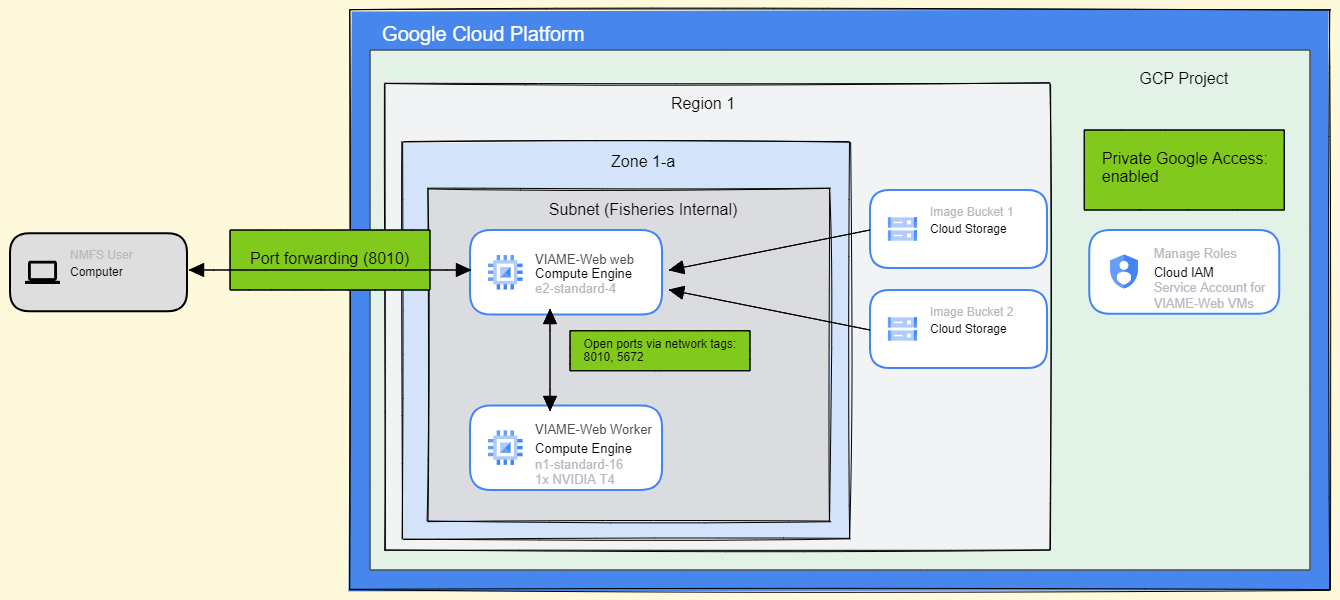OCIO approval process
June-September 2023
OCIO Project Onboarding
In June we were directed to and submitted the Fisheries OCIO Project Management Office Services Request Form from their project onboarding page. This form asked about the business case, POCs, background information about the project, a problem statement, the proposed solution to the problem, what alternatives were considered and why they did not satisfy needs, alignment with mission goals, risk considerations, project mandates, funding availability, resource needs, and implementation deadline.1 Some of this information was able to be taken from previous requirements gathering efforts and some from funding proposals.
Meeting with OCIO
Our first call with OCIO in late July was to discuss the project with the project management and implementation teams. An action item from this meeting was for the SEFSC to identify and assign users to different roles:
- Project Owner: Primary POC of the SEFSC-VIAME-Cloud project responsible for the overall operations of the product itself. This person also manages roles within the project and assigns them to specific groups or individuals in GCP.
- Compute Admin: Ability to log into virtual machine (VM) instances with administrative privileges, run and install software, and perform necessary updates. Should be an OMI/IT role.
- Compute User: End users of the VIAME instance. These are mostly SEFSC science staff.
- Storage Admin: Ability to create storage buckets and assign access permissions. Generally an OMI/IT role but does not necessarily need to be.
- Security Admin: Ability to manage security policies, network tagging, and liaise between science team (end users) and the FMC security team. Should be an OMI/IT role.
- Cloud Project Admin: Ability to manage the project infrastructure. Generally an OMI/IT role but does not necessarily need to be.
- Billing Viewer: Ability to monitor project costs via the GCP costs dashboard. Could be science or OMI/IT role, or both.
- Data engineer: Manages data upload, storage, and organization within the cloud storage buckets.
- App Developer: Ability to build out applications within the GCP cloud project. Should be an OMI/IT role.
Business Pitch to OCIO
Next we had to make a business pitch to OCIO Project Governance Board (PGB) to again justify the project. OCIO scheduled us to go before their project review board – which met once a month – in mid-August to explain our project, what we needed, why we needed it, who would be managing it, and so forth. This was an opportunity for the PGB team to ask any clarifying questions or provide guidance if they felt the project was not yet ready for deployment. Our project was well-defined and scoped by this point, so there were not many questions or clarifications. One outcome of this meeting was a follow up call involving SEFSC IT staff who would ultimately be responsible for provisioning and managing the cloud infrastructure once the project was deployed by OCIO. This meeting helped identify the best people for the IT roles listed above.
OCIO Project Charter
At the end of August we were tasked by OCIO with writing a non-technical project charter. This involved writing up the business case, explaining how and why the project was necessary, what resources were needed, and who were the end users and stakeholders. After a couple iterations and revisions, this document was signed by the SEFSC FATES Division Director and submitted for approval in mid-September.
We also needed to provide a technical diagram, and at this point we learned that the SWFSC had created one for their project. They graciously shared their diagram (Fig 1), since we were replicating their implementation, and this was passed along to OCIO to accompany the charter.

Footnotes
This form has since been streamlined by OCIO and now only has a few questions.↩︎
